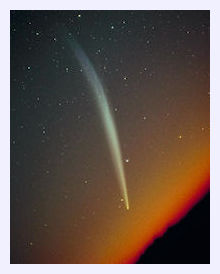"The storm began on Dec 13th and ended on the 22nd," says Karl Battams of the Naval Research Lab in Washington, DC. "During that time, the Solar and Heliospheric Observatory (SOHO) detected 25 comets diving into the sun. It was crazy!"
Sundiving comets - a.k.a. "sungrazers" - are nothing new. SOHO typically sees one every few days, plunging inward and disintegrating as solar heat sublimes its volatile ices. "But 25 comets in just ten days, that's unprecedented," says Battams.
"The comets were 10-meter class objects, about the size of a room or a house," notes Matthew Knight of the Lowell Observatory in Flagstaff, Arizona. "As comets go, these are considered small."
SOHO excels at this kind of work. The spacecraft's coronagraph uses an opaque disk to block the glare of the sun like an artificial eclipse, revealing faint objects that no Earth-bound telescope could possibly see. Every day, amateur astronomers from around the world scrutinize the images in search of new comets. Since SOHO was launched in 1996, more than 2000 comets have been found in this way, an all-time record for any astronomer or space mission.
Battams and Knight think the comet-storm of Dec. 2010 might herald a much bigger sungrazer to come, something people could see with the naked eye, perhaps even during the day.
"It's just a matter of time," says Battams. "We know there are some big ones out there."

These sungrazers are all related to one another. Astronomers call them the "Kreutz family" after the 19th century astronomer Heinrich Kreutz who first studied them as a group. Modern thinking about the family is attributed to Brian Marsden (1937-2010) of the Harvard Minor Planet Center. He analyzed the orbits of Kreutz comets and saw that they probably came from the breakup of a single giant comet in the 12th century, probably the Great Comet of 1106. According to Marsden's work, Ikeya-Seki-class comets and the smaller SOHO sungrazers are just different-sized fragments of that one progenitor.
Researchers Zdenek Sekanina and Paul Chodas of JPL modeled the fragmentation of the Kreutz progenitor, and in a 2007 issue of the Astrophysical Journal suggested that more big chunks were on the way. Knight's own counting of SOHO sungrazers supports their idea.
"Since SOHO was launched there has been a trend of increasing numbers of Kreutz sungrazers," he points out. A table in Knight's 2008 PhD thesis shows SOHO detecting 69 sungrazers in 1997 compared to 200 sungrazers in 2010. "The increase is significant and cannot be accounted for by improvements in SOHO or the increasing skill of comet hunters."
Was Comet Ikeya-Seki preceded by a storm like that of Dec. 2010?
No one knows.
"We have not seen a really big Kreutz comet in the era of space-based coronagraphs," notes Knight. "SOHO wasn't around in 1965 to record how many little comets dove into the sun before Ikeya-Seki. It might be 200 comets per year--or it could be 1000. Without more information, we can't know for sure how soon we might be privileged to see one of the real monsters."
Battams offers this advice: "Stay tuned to SOHO."



"Comet Ikeya-Seki is a good example. In 1965 it appeared out of nowhere, dove toward the sun and swooped over the stellar surface only 450,000 km away. Because Ikeya-Seki's nucleus was large, about 5 km wide, it survived the encounter and emerged as one of the brightest comets of the past thousand years."
Mercury's average distance from the Sun is about 60 million km and the temperature on its sunlit side reaches around 750 F.
Yet we are supposed to believe that a so-called "dirty snowball" didn't completely vaporize when passing within 450,000 km of the Sun.